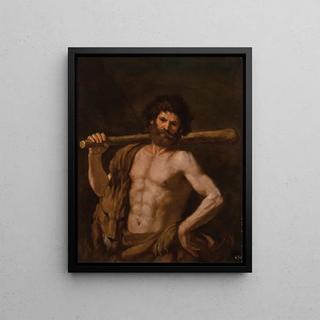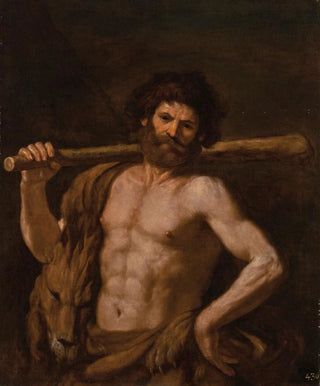Art print | Hercules - Guercino


View from behind

Frame (optional)
Art print Hercule - Guercino – Engaging Introduction
The "Hercule" art print by Guercino, a true masterpiece of Baroque painting, embodies the strength and nobility of the mythological hero. This painting, with its dynamic composition and masterful use of light, invites the viewer to immerse themselves in a universe where power and beauty converge. Guercino, whose real name is Giovanni Francesco Barbieri, manages to capture the very essence of the character Hercule, hero of Roman mythology, known for his epic feats and legendary bravery. The depiction of this iconic figure goes beyond a simple illustration, elevating itself to a genuine celebration of human strength and the struggle against adversity.
Style and uniqueness of the art print
Guercino's style is distinguished by his ability to combine realism and expressionism. In "Hercule," the meticulous details of the prominent muscles and flowing drapery demonstrate remarkable technical mastery. Light plays a central role in the composition, creating striking contrasts that emphasize the hero's power while giving him an almost divine dimension. The colors, rich and vibrant, evoke a dramatic atmosphere that transports the viewer to a moment of tension and triumph. Every brushstroke seems to vibrate with palpable energy, making the art print lively and immersive. Guercino thus succeeds in transcending mere portraiture to offer a true aesthetic experience, where each element contributes to the harmonious whole.
The artist and his influence
Guercino, born in the early 17th century, left his mark on his era with his unique style and his ability to innovate within the Baroque movement. Influenced by masters such as Caravaggio, he developed a personal approach that combines clarity of forms with deep emotional expressiveness. His work has had a lasting impact on many artists, especially in Italy, but also beyond its borders. By incorporating elements of classical mythology into his compositions, Guercino paved the way for a new interpretation of ancient stories, making these tales accessible and relevant for his time. His legacy is still felt today, both in painting and in other art forms, where the exploration of themes

Matte finish

View from behind

Frame (optional)
Art print Hercule - Guercino – Engaging Introduction
The "Hercule" art print by Guercino, a true masterpiece of Baroque painting, embodies the strength and nobility of the mythological hero. This painting, with its dynamic composition and masterful use of light, invites the viewer to immerse themselves in a universe where power and beauty converge. Guercino, whose real name is Giovanni Francesco Barbieri, manages to capture the very essence of the character Hercule, hero of Roman mythology, known for his epic feats and legendary bravery. The depiction of this iconic figure goes beyond a simple illustration, elevating itself to a genuine celebration of human strength and the struggle against adversity.
Style and uniqueness of the art print
Guercino's style is distinguished by his ability to combine realism and expressionism. In "Hercule," the meticulous details of the prominent muscles and flowing drapery demonstrate remarkable technical mastery. Light plays a central role in the composition, creating striking contrasts that emphasize the hero's power while giving him an almost divine dimension. The colors, rich and vibrant, evoke a dramatic atmosphere that transports the viewer to a moment of tension and triumph. Every brushstroke seems to vibrate with palpable energy, making the art print lively and immersive. Guercino thus succeeds in transcending mere portraiture to offer a true aesthetic experience, where each element contributes to the harmonious whole.
The artist and his influence
Guercino, born in the early 17th century, left his mark on his era with his unique style and his ability to innovate within the Baroque movement. Influenced by masters such as Caravaggio, he developed a personal approach that combines clarity of forms with deep emotional expressiveness. His work has had a lasting impact on many artists, especially in Italy, but also beyond its borders. By incorporating elements of classical mythology into his compositions, Guercino paved the way for a new interpretation of ancient stories, making these tales accessible and relevant for his time. His legacy is still felt today, both in painting and in other art forms, where the exploration of themes






